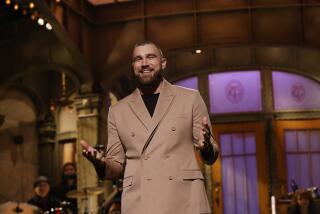Cable Puts TV Ads Under a Microscope
The United States is a nation of illiterates.
It’s true that all but a tiny percentage of its population can read and write. It’s media literacy--an understanding of the nature of the message and the system that delivers it--where the sheer drop-off occurs.
In today’s electronic age, media literacy is arguably as important as history or math. If only it were a regular part of every school curriculum.
Fortunately, class is convening at 7:30 tonight on HBO with “Buy Me That 3!”--a half-hour program from Consumer Reports that guides kids through a Madison Avenue minefield of food advertising on TV. More than just smart and funny, it’s indispensable.
The HBO program is one of two airing this week that address the power of TV commercials. The other, “Butt Out: The Life & Death of Cigarette Advertising on TV,” airs at 5 p.m. and 9 p.m. Friday on cable’s Arts & Entertainment Network.
Based in part on the Consumer Reports kids’ magazine Zillions, this is the third annual “Buy Me That!” on HBO, a cable network that, because it’s funded by subscriptions and accepts no paid advertising, can safely question the honesty or integrity of commercials without fear of fiscal retribution.
“Buy Me That 3!” aims its own distinctive microscope at the fine print of commercial techniques and product selling. “Food commercials can make anything look delicious or sound really healthy,” says host Jim Fyfe. Thus, although this wise and entertaining program’s format aims young, it’s also applicable to adults.
It presents “The Cola Challenge,” a Coke/Pepsi/RC test with 72 chug-a-lugging youngsters that challenges advertising claims about taste differences.
It urges skepticism about nutritional claims and pictures of fruit on packages of candy (“Don’t confuse them with real fruit”).
It separates fruit drinks from fruit juice.
It explains that the chances of winning a packaged-food sweepstakes offer are less than those of “your teacher being struck by lightning before finals.”
It cites the sugar levels of breakfast cereals and notes which are virtually “breakfast candies.”
It reveals the tricks that advertisers use to artificially enhance the visual appeal of burgers and other foods. (A suggestion for a future show: In addition to displaying the cosmetic burger, show or at least mention the entire food-making process--from cattle ranch to slaughterhouse to oven--so that the animal being eaten won’t be such an abstraction.)
What “Buy Me That 3!” defines so effectively is the seductiveness of advertising. “You think you absolutely need it or else you’re gonna die,” a boy says about a food sold on the screen.
It’s just that kind of mismatch--between advertiser and child--that the program attempts to redress, according to Joyce H. Newman, who heads the television arm of Consumer Reports, which has co-produced a spate of other programs with HBO and also syndicates news inserts for local newscasts.
“We are not anti-advertising,” she said from her office in Yonkers, N.Y. “What we want is a level playing field, and it is not level when you have young consumers with very few skills at the receiving end of sophisticated marketing. There are 3- and 4-year-olds being targeted, and we feel they need to have their own program where they can talk and where they can get the skills to deal with the economic pressures.”
They aren’t about to learn those skills from commercial television. “The salespeople would be very upset” if “Buy Me That!” aired on their outlet, Newman said, “because they are trying to bring in advertising revenue and we’d be biting the hand that feeds them.”
Public television is fed by a different hand, though. Thus, the Connecticut Public Television network is a partner with Consumer Reports in the making of a pilot for a series (now tentatively called “Zillions TV”) that, while having a somewhat different format and a broader consumer agenda, would incorporate many of the elements of “Buy Me That!” Newman said the series would be broadcast on the Connecticut network and that the pilot would be submitted to PBS for consideration.
With its wide exposure, PBS would be the perfect locale for a consumer series aimed at kids.
“Children don’t understand about their bodies,” Newman said. “They think they’re immortal. At a time when we are introducing all these low-on-fat products for adults, what we’re introducing to kids are new sugared cereals. What I hope to say to kids is that the beautiful new cereal being introduced with little bears is 53% sugar.”
Butting In: In another era, kids drooling over today’s cereal ads could have been just as easily seduced by the cigarette commercials whose rise and fall are traced on Friday’s “Butt Out,” an hour from Rob Weller and Gary H. Grossman that’s airing under the banner of the A&E;’s “Time Machine” series.
Because of the incestuous link between programmers and advertisers (including the tobacco industry) until the late 1950s, “Butt Out” is as much a history of early TV as of the medium’s cigarette advertising. In those early days, when sponsors were identified with entire shows, cigarette advertisers were allowed to virtually control the contents of the shows they underwrote.
Talk about infomercials--take a look at 1949 excerpts of comedian Ed Wynn doing an 11-minute sketch built around his show’s sponsor, Camel cigarettes. And whether it’s the whole world calling for Phillip Morris or Winston tasting good like a cigarette should, commercial after commercial rolls across the screen here, each promoting smoking as a social, sexy or otherwise desirable thing to do.
The glossy campaigns include such slick TV hucksters as Old Gold spokesman Dennis James, who, former advertising man Grant Tinker recalls, “sold a cigarette the way Sinatra sold a song.” James, taking a deep draw, then exhaling contentedly: “Yes . . . pleasure.”
Ultimately, it was the notorious quiz show scandals of the late 1950s that pushed sponsors out of programming and the tobacco-condemning Surgeon General’s report in 1964 that began the process of shoving cigarette ads from television. In 1969, they were legislated off the air.
Although an interesting time capsule, “Butt Out” omits the pre-TV cultural phenomenon of cigarette smoking and fails to show how the tobacco industry has sustained in the present era of anti-smoking hostility by using print and other venues to direct its message toward lower economic groups and young people.
Cigarette advertising vs. the young? Sounds like fodder for a consumer show. Start leveling the playing field now.
More to Read
The complete guide to home viewing
Get Screen Gab for everything about the TV shows and streaming movies everyone’s talking about.
You may occasionally receive promotional content from the Los Angeles Times.






